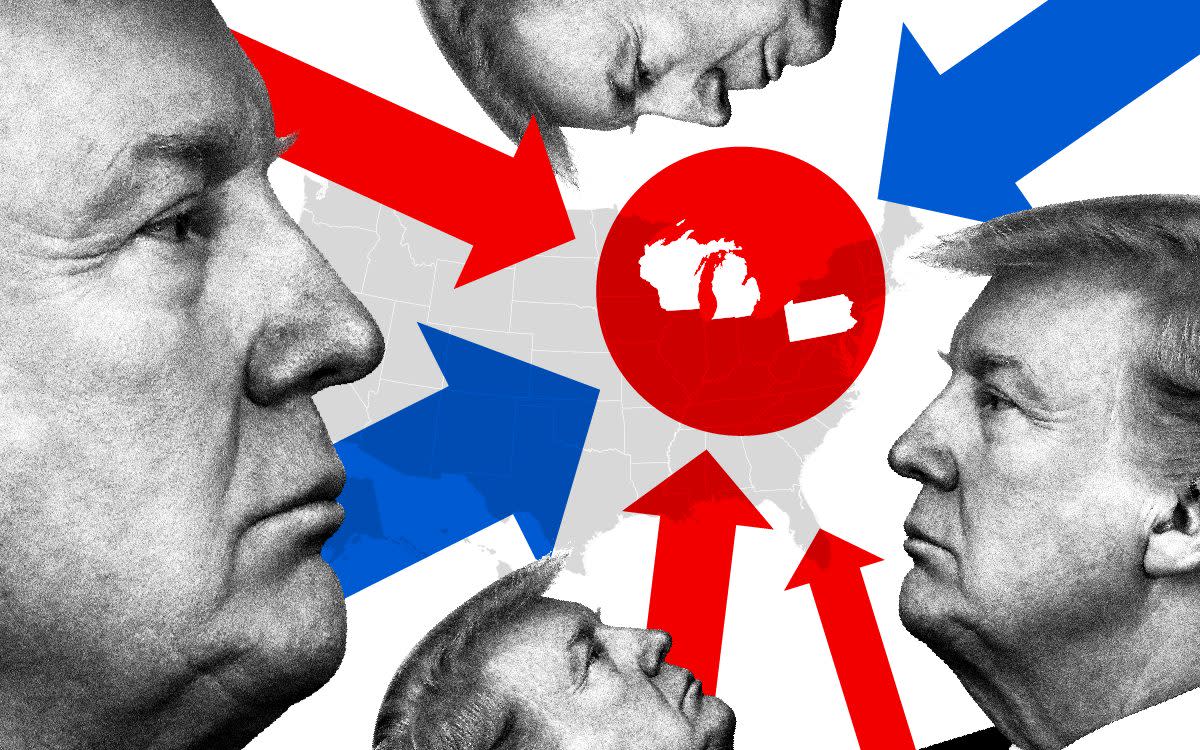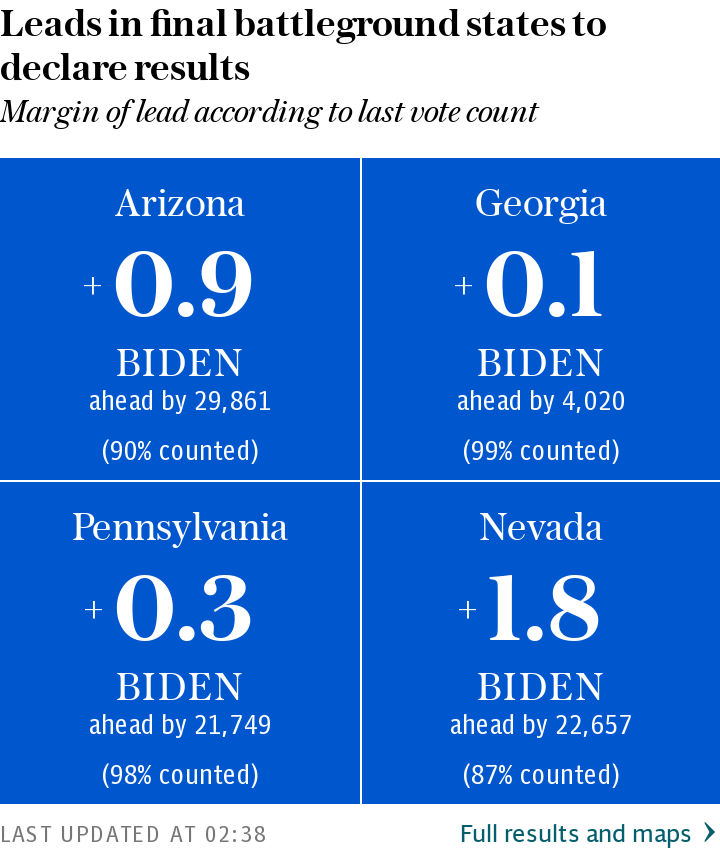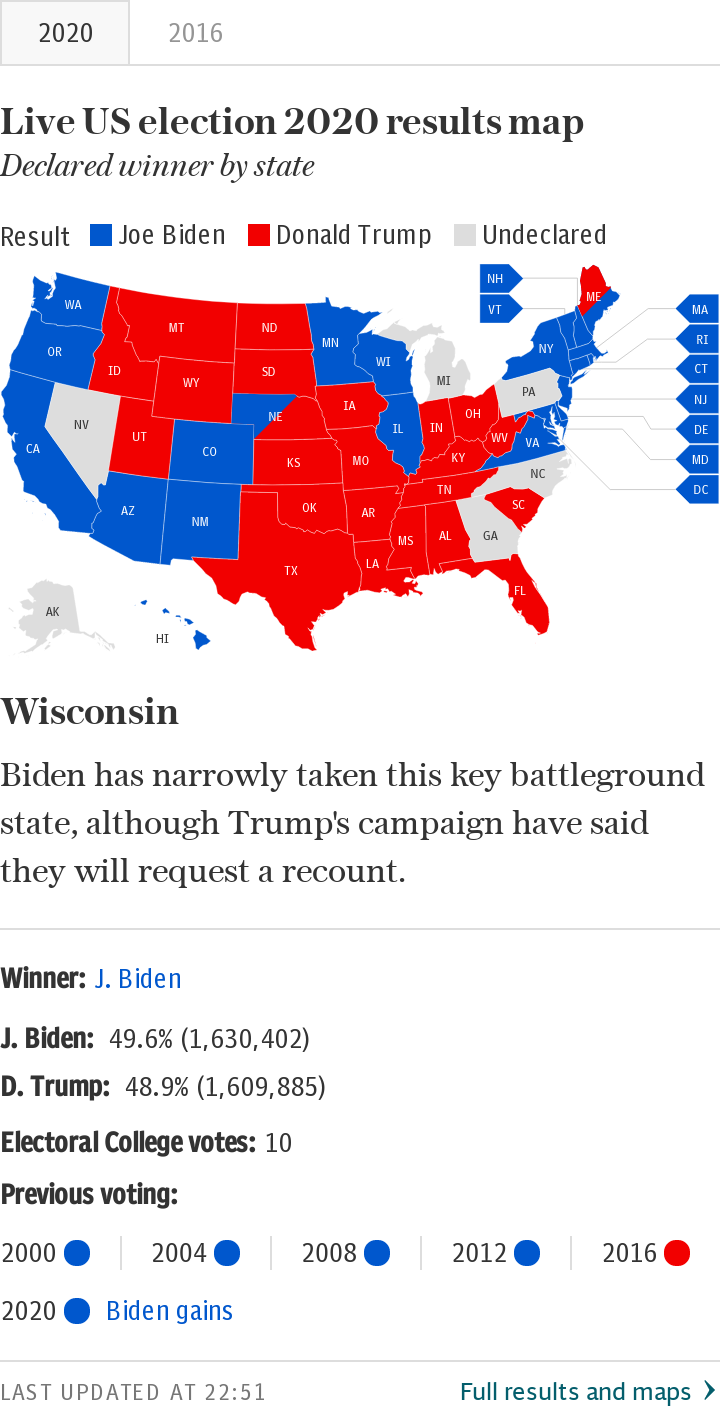How key states voted in the 2020 election, as Joe Biden closes in on US Presidency

- Oops!Something went wrong.Please try again later.
Joe Biden is now within touching distance of the Presidency as he continues to eat into incumbent Donald Trump's leads in remaining key states.

Ahead of election day many pollsters predicted a comfortable victory over Donald Trump, but after the incumbent held his grip on a series of influential states the US presidential race is now going down to the wire.
A larger than expected Hispanic support seems to have helped Trump cling on - but the eventual winner will now be determined by the thousands of mail-in ballots that are still being counted.
Once again a handful of states - including Pennsylvania and Georgia - will be instrumental in who enters the White House next year.

How the night played out
With Florida claimed by Trump, and Biden on course to pick up the historically red state of Arizona, the contest was too close to call by the time election day drew to a close.
The contest rested on as yet uncounted votes in battleground states, with Trump sowing seeds of mistrust among his supporters over mail-in ballots and threatening to go to the Supreme Court.
By the time a victory speech could have been expected, Pennsylvania, Michigan, Wisconsin, Georgia, Nevada and North Carolina were still up for grabs, with Trump leading in all but Wisconsin and Nevada.
Alaska, a solid Republican state, had not yet declared, and questions remained over the count in Arizona, which the Associated Press and Fox News declared for Biden but others were more cautious.

A key turning point in the night was Florida declaring for Trump, with its 29 electoral college votes, at around 6am GMT.
It was a clear indication of how the polls had once again underestimated Trump's support base, with Biden expected to take the state in late polling.
But fortunes began to reverse for the Democrats as millions of mail-in votes started coming in, and when Michigan turned blue - one of the few states to change colour after Trump's shock win in 2016 - Biden's chances of securing the Presidency heightened.
After Trump declared no more votes should be counted, supporters have been picketing polling booths and calling for a halt to the count.
Many pundits anticipated the tactic in the event of no clear winner emerging on election day - and it remained all to play for in the key battleground states which have not yet seen a winner declared.
As the hours dragged on Biden toppled Trump's leads - first in Georgia where he is now just a few hundred votes ahead, then in Pennsylvania - a huge turning point in the race.
How were the polls so wrong?
Before polling stations closed many anticipated a clear victory for Biden, who ended the campaign more than eight points clear of Trump on the national polls.
But as the electoral map continued to turn red - with an almost exact replica of the 2016 results - it became clear the contest would be far closer than first thought.
Only after Michigan and Wisconsin flipped to Biden, and the remaining mail-in votes - heavily weighted Democrat - started to flood in did the gap begin to close.
With the majority of the votes counted the margin of error from pollsters across the country became clear, with Biden failing to take hold of a clutch of states which could have handed him a landslide.
According to the final state polling Biden held narrow leads in Florida and Ohio, running a close second to the incumbent in Iowa.
With the caveat a large number of votes remain to be counted, and are likely to improve the Democratic share, Trump appears to have over-performed in many states compared to pollsters' predictions.
In Iowa Biden trailed Trump by 8.2 points with 99 per cent having reported. Final polling gave the Democrat a tight 1.5 point lead.
In Florida Biden was polling 2.1 points ahead of Trump, but lost the state by 3.3.
Early indications also suggest the polls may have underestimated the Hispanic support Trump could wield.
In the 2016 election 28 per cent of Hispanic men voted for Trump, but according to exit poll data that number rose to 36 per cent this year, while support among Hispanic women remained steady.
But while Trump's base four years ago was cemented among white men, his support among the demographic appears to have waned this year.
In 2016 62 per cent of white men voted for Trump, while exit polls suggest that number has fallen to 58 per cent this year.
Among white women, however, the President appears to be more popular, with his vote share in 2016 of 47 per cent rising to 55 per cent.
How key states voted
Donald Trump's chances were boosted with the declaration of Florida, while Joe Biden edged within touching distance of the White House when he flipped Michigan back to the Democrats.
The influence of the Hispanic vote is borne out in county-level results for Florida, which was a turning point on election night when it was declared for Trump.
Many counties in Florida have significant Hispanic populations, and in many the Democratic vote share has disintegrated since 2016.
In Miami-Dade - 68 per cent Hispanic - Trump's vote share was more than 20 points up from 2016
In Osceola and Hendry counties (both 53 per cent Hispanic), Biden's vote was 6.9 and 8.8 points down from 2016.
In Michigan Democratic success pivoted on a few key urban counties, with Biden securing more support within higher educated areas than his predecessor had four years earlier.
In the most populous area - Wayne County, home of Detroit - the Democratic vote share held firm from 2016.
It was boosted by large increases in support among counties with high proportions of college graduates, with increases in vote share of almost 10 points in Kent County and Grand Traverse County, each with around 50 per cent of over 25s having a college degree.
While pollsters had expected a 'blue wave' heading into election night, the following few days produced a 'blue shift' - with Democratic fortunes improving as mail-in ballots continued to flood in.
But it remained closer than many predicted in another difficult night for pollsters and pundits.

